
Phyllomedusa is a genus of tree frogs in the subfamily Phyllomedusinae found in tropical and subtropical South America and Panama. It has 16 recognised species.

Walkerana phrynoderma is a species of frog endemic to the Anaimalai Hills, of the Western Ghats of Kerala and Tamil nadu states in southern India. This species is known from Munnar, Eravikulam National Park, Valparai tea gardens, Anamalai Tiger Reserve, Grass Hills National Park and Palni hills. It is a very rare terrestrial frog species associated with leaf-litter in tropical moist forest. It is threatened by habitat loss caused by subsistence wood collecting. It has the status of one of the "Top 100 Evolutionarily Distinct and Globally Endangered Amphibians".
The heavenly hill rat is a species of rodent in the family Muridae. It is found only in southwestern Sulawesi, Indonesia, where it has only been found on Mount Lompobatang. Its natural habitat is subtropical or tropical dry forest. It is threatened by habitat loss.
Centrolene sanchezi is a species of frog in the family Centrolenidae. It is found in the Andes mountains in Colombia and Ecuador. Its natural habitats are subtropical or tropical moist montane forests and rivers.

Dendropsophus phlebodes, the San Carlos treefrog or San Carlos dwarf treefrog, is a species of frog in the family Hylidae. It is found in western Colombia, Costa Rica, Nicaragua and Panama. Its natural habitats are tropical moist lowland forests, but it may also occur in disturbed habitats. It is threatened by habitat loss.
The Lema tree frog is a species of frog in the family Hylidae found in Guyana, Venezuela, and possibly Brazil. Its natural habitats are subtropical or tropical moist lowland forests, subtropical or tropical moist montane forests, rivers, pastureland, rural gardens, heavily degraded former forests, aquaculture ponds, and canals and ditches. It is threatened by habitat loss.
The La Escalera tree frog is a species of frog in the family Hylidae found in Guyana, Venezuela, and possibly Brazil. Its natural habitats are subtropical or tropical moist lowland forests, subtropical or tropical moist montane forests, rivers, and freshwater marshes.
Nesorohyla is a monotypic genus of frogs in the family Hylidae. The sole species is Nesorohyla kanaima, also known as the Kanaima treefrog. It is endemic to Guyana. and possibly Brazil and Venezuela. Its natural habitats are subtropical or tropical moist lowland forests, subtropical or tropical moist montane forests, and rivers.

Phyllomedusa distincta is a species of frog in the subfamily Phyllomedusinae, endemic to Brazil. Its natural habitats are subtropical or tropical moist lowland forests and freshwater marshes. It is threatened by habitat loss.
Callimedusa ecuatoriana is a species of frog in the subfamily Phyllomedusinae. It is endemic to Ecuador and known from the Amazonian slopes of the Andes in the Morona-Santiago Province as well as from Cordillera del Condor in the Zamora-Chinchipe Province. Common name Agua Rica leaf frog has been proposed for it.
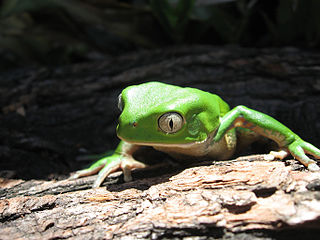
Phyllomedusa iheringii is a species of frog in the subfamily Phyllomedusinae. It is found in southernmost Brazil and Uruguay. The specific name iheringii honors Hermann von Ihering, a German-Brazilian zoologist. However, common name southern walking leaf frog has been proposed for it.
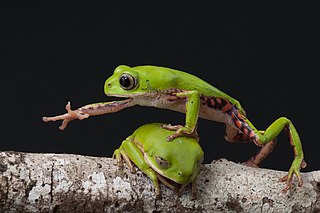
Pithecopus rohdei, also known as Rohde's leaf frog, Rohde's frog, and Mertens' leaf frog, is a species of frog in the subfamily Phyllomedusinae. The species was previously placed in the genus Phyllomedusa. The species is endemic to southeastern Brazil and occurs at elevations up to 1000 meters above sea level.

Phyllomedusa tetraploidea is a species of frog in the subfamily Phyllomedusinae. It is found in northern Argentina, extreme southeastern Paraguay, and southern Brazil. It occurs in rainforest on herbaceous vegetation near swamps at elevations of 400–1,000 m (1,300–3,300 ft) above sea level. It also occurs in secondary forest and pastures. The eggs are deposited in leaf nests above the water in permanent forest pools; the tadpoles develop in the pools. It is a common species in Brazil and Argentina. Habitat loss caused by agricultural activities is a threat to it. It is present in several protected areas.
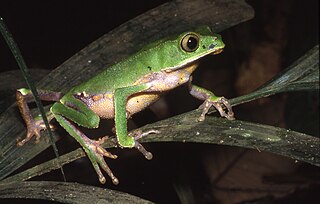
The white-lined leaf frog is a species of frog in the subfamily Phyllomedusinae. It is found in northern South America. Its natural habitats are subtropical or tropical moist lowland forest, subtropical or tropical swampland, rivers, and freshwater marshes. It is threatened by habitat loss.
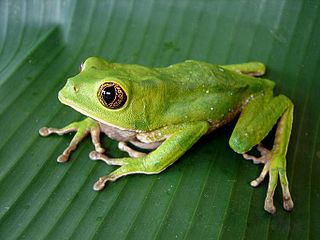
Phyllomedusa venusta is a species of frog in the subfamily Phyllomedusinae, found in Colombia and Panama. Its natural habitats are subtropical or tropical dry forests, subtropical or tropical moist lowland forests, swamps, freshwater marshes, intermittent freshwater marshes, and heavily degraded former forests. It is threatened by habitat loss.
Stefania ackawaio is a species of frog in the family Hemiphractidae. It is endemic to Guyana. Its natural habitat is subtropical or tropical moist montane forests.
Stefania coxi is a species of frog in the family Hemiphractidae. It is endemic to Guyana and has been found on Mount Ayanganna and Mount Wokomung. Its natural habitat is subtropical or tropical moist montane forests at higher elevations.

Pithecopus azureus is a species of frog in the subfamily Phyllomedusinae that lives in Brazil, Paraguay, Argentina, Bolivia, and Peru.
Phyllomedusa neildi is a species of frog in the family Hylidae endemic to Venezuela. Scientists know this frog solely from its type locality: Sierra de San Luís.
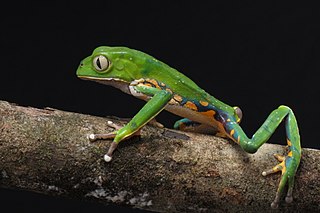
Phyllomedusa bahiana is a species of frog in the family Hylidae endemic to Bahia and Brazil. Scientists have seen it in mountain habitats, between 280 and 1000 meters above sea level.











